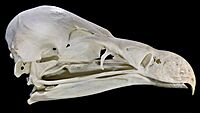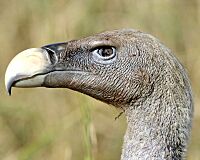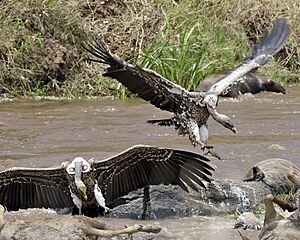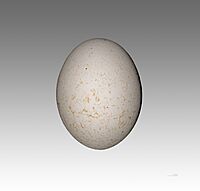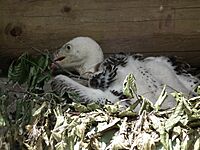Rüppell's vulture facts for kids
Quick facts for kids Rüppell's vulture |
|
|---|---|
 |
|
| In the Masai Mara, Kenya | |
| Conservation status | |
| Scientific classification | |
| Genus: |
Gyps
|
| Species: |
rueppelli
|
| Subspecies | |
|
|
The Rüppell's vulture (Gyps rueppelli) is a very large bird of prey. It is also known as the Rüppell's griffon vulture. This bird was named after Eduard Rüppell.
These vultures mostly live in the Sahel region and East Africa. Sadly, their numbers have been going down. This is due to losing their homes, accidental poisoning, and other reasons. Rüppell's vultures are known for flying higher than any other bird. One was even seen flying at 11,300 meters (37,000 feet) above the sea!
Contents
Where Rüppell's Vultures Live
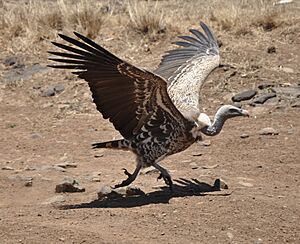
Rüppell's vultures are found across the Sahel region and East Africa. They live in grasslands, mountains, and woodlands. These birds used to be very common in these areas. However, their numbers are now dropping quickly. This is especially true in the western parts of their home range.
What Rüppell's Vultures Look Like
The Rüppell's vulture is a big bird. It is larger than the white-backed vulture, which it often shares its home with. Adult vultures are about 85 to 103 centimeters (33 to 41 inches) long. Their wings can spread from 2.26 to 2.6 meters (7.4 to 8.5 feet) wide. They weigh between 6.4 and 9 kilograms (14 to 20 pounds).
Both male and female vultures look alike. They are mostly mottled brown or black. Their belly is whitish-brown. Their head and neck are covered with thin, dirty-white fluff. They have a white collar at the base of their neck. Their eyes are yellow or amber.
Their head does not have feathers. This helps them stay clean when they stick their heads inside animals to eat. If they had feathers, eating would be very messy. These vultures are usually quiet. But they can get noisy at their nest or when eating a carcass. They often squeal a lot.
Rüppell's vultures often fly as high as 6,000 meters (20,000 feet). They have a special protein in their blood called hemoglobin. This protein helps them get enough oxygen even when the air is very thin. One Rüppell's vulture was even sucked into a jet engine. This happened on November 29, 1973, in Ivory Coast. The plane was flying at 11,300 meters (37,000 feet).
How Rüppell's Vultures Behave
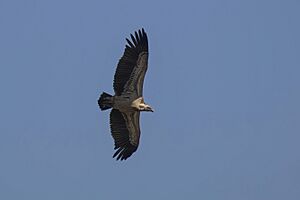
These vultures cruise at about 35 kilometers per hour (22 miles per hour). They fly for 6 to 7 hours every day. They can travel as far as 150 kilometers (93 miles) from their nest to find food.
What Rüppell's Vultures Eat
Rüppell's vultures only eat carrion, which means dead animals. They often follow herds of animals as they move. They gather in large groups at carcasses, usually with other types of vultures. They might eat animals killed by a lion or other predators. They also eat animals that died from injuries, sickness, or old age. They prefer fresh meat but can eat older carcasses too.
Rüppell's vultures have special features that help them eat. They are very strong birds. After eating the soft parts of an animal, they will eat the hide and even the bones. They eat so much that they can barely fly afterward. They have backward-pointing spikes on their tongue. These spikes help them pull meat off bones. Even though they are big and strong, they are not the most dominant vulture. The larger lappet-faced vulture is usually in charge at a carcass.
Life Cycle and Reproduction
Rüppell's vultures are monogamous, meaning they stay with one partner for life. After finding a mate, the pair builds a nest together. They use sticks, grass, and leaves. Sometimes they even steal materials from other nests!
These vultures build their nests on cliffs. In some areas, many pairs nest together in large groups. Both parents take turns sitting on their single egg. The egg hatches after about 55 days. Once the chick is born, both parents feed and care for it. The chick learns to fly after about 150 days. Young vultures stay with their parents until the next breeding season. During this time, they learn how to find food and compete with other vultures.
Protecting Rüppell's Vultures
Since 1988, the number of Rüppell's vultures has been going down. The International Union for Conservation of Nature (IUCN) first listed them as "near threatened" in 2007. This means they were close to being endangered. From 2012 to 2014, they were listed as Endangered. But in 2015, their status changed to Critically Endangered. This is the highest risk category, meaning they are very close to disappearing.
Rüppell's vultures are also listed under CITES Appendix II. This means their international trade is controlled. It helps make sure that trading these birds does not threaten their survival.
It is thought that there are about 22,000 Rüppell's vultures left. Specific numbers include:
- Tanzania: 3,000 pairs
- Kenya: 2,000 pairs
- Ethiopia: 2,000 pairs
- Sudan: 2,000 pairs
- West Africa: 2,000 pairs
Since 1992, Rüppell's vultures have sometimes been seen in Spain and Portugal. They are usually found near Cádiz and the Strait of Gibraltar.
Dangers to Rüppell's Vultures
Rüppell's vulture populations are shrinking everywhere they live. This is due to several main problems:
- Loss of habitat: Humans are changing the land, leaving less space for the vultures.
- Poisoning: This is the biggest danger. Vultures are usually not the target. Farmers sometimes put poison in dead animals to kill predators like lions or hyenas. Vultures then eat these poisoned carcasses. One poisoned animal can kill hundreds of vultures.
- Use in traditional medicine: In some African cultures, vultures are used for medicine or magic. People believe vultures can see the future or make children smarter. This leads to many vultures being killed.
- Loss of nesting sites: There are fewer safe places for them to build nests.
- Less food: There are fewer dead animals for them to eat.
Creating protected wildlife areas can help save Rüppell's vultures. These vultures breed and nest on cliffs in northern and southern Kenya, and Tanzania. These areas attract huge numbers of vultures. Protecting these key breeding sites could help their population grow.
See also
- The white-backed vulture, which is a bit smaller and has a shorter neck.
- List of birds by flight heights



